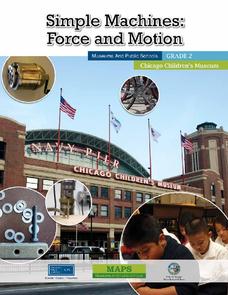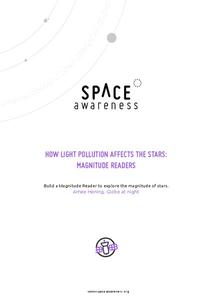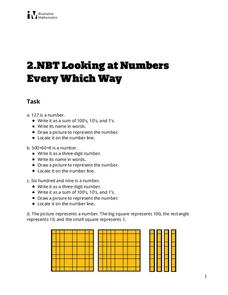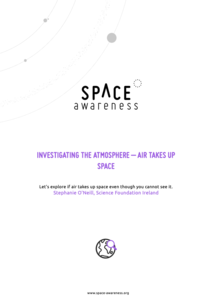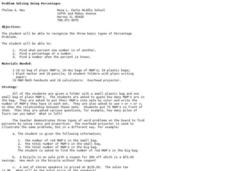Space Awareness
Seasons Around the World
Why does Earth experience summer, fall, winter, and spring? Using an informative demonstration, learners see how the angle of the sun on Earth and the rotation of Earth determine the seasons. Scholars work in pairs to learn that the...
Space Awareness
What is Time?
Does it ever seem like time is slipping through your fingers? Model the passing of time with an hourglass activity in which individuals determine whether hourglasses are the most efficient way to measure time.
PBS
Hidden Alarm
It's time! The fourth lesson in a five-part series has teams of scholars build a circuit for an alarm. A switch lets them turn the alarm on and off and allows them to hide the alarm—just as long as they don't hide it in the classroom!
Curated OER
My Foot and the Standard Foot
Young mathematicians put one foot in front of the other as they learn how to measure length in an elementary math lesson. Using paper cutouts of their own feet, children measure classroom objects as they discover the importance of...
Curated OER
Teaching Word Meaning Synonyms, Antonyms, and Analogies
Strengthen and enhance your class's vocabulary with a guided activity on word relationships. Focusing on synonyms and antonyms, the activity demonstrates ways to compare and define different words, including word analogies and thesaurus...
Space Awareness
Model of a Black Hole
Even light cannot leave the force of a black hole! Learners use a model to explore the gravitational force of a black hole. An elastic bandage and heavy ball serve to create the hole, while marbles become the victims of its strong force.
Houghton Mifflin Harcourt
Finding Subjects and Predicates
Diagramming sentences has never been easier. Four worksheets feature exercises on simple subject and predicates, complete subjects and predicates, as well as compound verbs. Kids indicate the parts of the sentences with circles and...
K12 Reader
The Rock Cycle
This cross-curricular reading comprehension learning exercise asks kids to read a passage of the rock cycle and then to use information in the article to respond to a series of questions.
K12 Reader
Phases of the Moon
Take one giant leap for mankind with a reading passage about the moon. Kids learn about the lunar cycle with context clues and reading comprehension questions, making it a good informational text for your language arts lesson.
Chicago Children's Museum
Simple Machines: Force and Motion
Get things moving with this elementary science unit on simple machines. Through a series of nine lessons including teacher demonstrations, hands-on activities, and science experiments, young scientists learn about forces, motion,...
Curated OER
Punctuation
Should that pause in your sentence be long, short, or somewhere in between? Practice using commas and semicolons with a series of grammar activities. High schoolers read a series of sentences and paragraphs and decide where they should...
Houghton Mifflin Harcourt
Around Town: Neighborhood and Community: Extra Support Lessons (Theme 3)
Neighborhood and community is the theme of a unit comprised of extra support lessons. Following practice pages and a teach, blend, guided practice, practice/apply routine, the series of lessons provide additional reinforcement...
Curated OER
Unit 2: Global to Local: Understanding My Place in the Hydrosphere
What does the ground around your home have to do with water pollution? Young ecologists learn about their local watershed and create their own cause-and-effect models of the hydrosphere.
Space Awareness
How Light Pollution Affects the Stars: Magnitude Readers
Did you know light can decrease visibility? Light pollution absolutely makes it more difficult to see stars. Scholars build a simple magnitude reader to determine the magnitude of stars. They use these data to estimate the impact of...
Illustrative Mathematics
Looking at Numbers Every Which Way
Assess class members' ability to look at numbers every which way. A helpful worksheet contain four tasks, including writing numbers as a sum of 100's, 10's, and 1's, and drawing a picture to represent the number.
Space Awareness
Investigating the Atmosphere - Air Takes Up Space
How do you know there is air? Can you see it, smell it, feel it? To begin the investigation, learners watch a video and discuss what they know about air and the atmosphere. Then, they participate in five different hands-on, inquiry-based...
Curated OER
What is a Philanthropist?
Students discover the concept of philanthropy. In this service learning lesson, students define the word philanthropist and create a flip-book based on The Lion and the Mouse.
Curated OER
Worms And More
Young scholars complete five center activities that in order to determine the attributes of length and area. They study the vocabulary associated with measurement of length and area. They use blocks, play dough, wrapping paper, and...
Curated OER
Scientific Notation
Students explore the concept of expressing numbers in scientific notation. In this scientific notation lesson, students understand the importance of using scientific notation by finding real world examples where scientific notation is...
Curated OER
Wall of Philanthropists: King Day (7th)
Young scholars recognize the importance of justice, tolerance, equality, and historical figures. In this philanthropic actions lesson, students study the philanthropic actions of historical figures, and learn about the concepts of...
Curated OER
Einstein's Big Idea
Students create a time line of scientists involved with E = mc2. They describe experiments that led to an understanding of energy, mass, the speed of light squared, and the equivalence of mass and energy. Students relate challenges...
Curated OER
Let's Make Lemonade Lesson 3: What's the Big Idea?
Students examine and decide on a service-learning project to perform. They design and execute posters that advertise the project using geometric shapes.
Curated OER
Outdoor Survival
Young scholars are introduced to basic outdoor survival concepts. They identify the seven basic needs for survival. Students describe the symptoms and treatment for frostbite and hypothermia. They compare and contrast the value of...
Curated OER
Problem Solving Using Percentages
Students explore the concept of percentages. In this percentages lesson, students find the percentages of various colored m&m's in their bags. Students find the cost of items before and after a discount. Students use proportions to...











